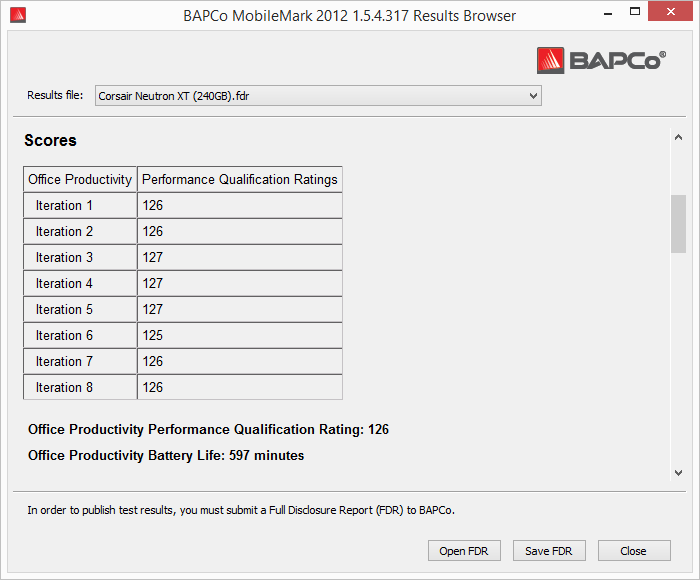Legacy Storage Benchmarking Methodology
Notebook Battery Life
Lab Notes
MobileMark 2012 v1.5 is an application-based benchmark that reflects usage patterns of business users in the areas of office productivity, media creation and media consumption. Unlike benchmarks that only measure battery life, MobileMark 2012 measures battery life and performance simultaneously, showing how well a system design addresses the inherent tradeoffs between performance and power management.
At this time, we use Bapco’s MobileMark 2012 v1.5 for our notebook battery life test. Bapco recently released MobileMark 2014, and we will eventually move to the new software after sorting out a few issues. MobileMark 2012 v1.5 ships with three test scenarios: Office Productivity, Media Creation/Consumption and Blu-ray. We use the Office Productivity benchmark exclusively.
We use two separate systems to run MobileMark 2012 v1.5. The first is a Lenovo T440, which tests 2.5" SATA HDDs and SSDs. It also allows us to benchmark mSATA SSDs.
The second system is a third-gen Lenovo X1 Carbon, which ships with M.2 storage for testing both SATA- and PCIe-based devices. Notebook battery life and performance results are not comparable between the two systems. At this time, we haven't found a single notebook that allows us to test all formats in the same machine.
MobileMark 2012 v1.5 installs and/or uses the following 13 applications:
- ABBYY FineReader Pro 11
- Adobe Acrobat Pro X
- Adobe Flash player 11
- Adobe Photoshop CS5 Extended 12.04
- Adobe Photoshop Elements 10
- Adobe Premiere Pro CS 5.5
- CyberLink PowerDVD Ultra 11
- Microsoft Excel 2010 SP1
- Microsoft Internet Explorer 9 (or newer if already installed)
- Microsoft Outlook 2010 SP1
- Microsoft PowerPoint 2010 SP1
- Mozilla Firefox 14.0.1
- Winzip Pro 16
In order to keep testing consistent, each notebook needs fresh batteries after just ten tests. This comes out to a new battery once every two months on average. To maintain consistent results, we use genuine Lenovo six-cell batteries for the T440 and Lenovo's internal battery for the X1 Carbon.
Get Tom's Hardware's best news and in-depth reviews, straight to your inbox.
When finished, we end up with two numbers. The first is a measurement in minutes, which tells us how long the notebook was powered on. The second one is a performance rating. In a low-power state, the notebook reduces bandwidth and clock rates on several components. The SATA bus, as well as the CPU, GPU, DMI link and DRAM drop to lower speeds to increase battery life. Our performance rating indicates efficiency when available power is the limiting factor.

Chris Ramseyer was a senior contributing editor for Tom's Hardware. He tested and reviewed consumer storage.
-
damric How I test an SSD. HARD RESET my computer 20 times. If the SSD is still recognized by the motherboard, then the SSD controller is worth a flip.Reply
SSDs will never wear out due to IOPs. Only the controllers break. Quit kidding yourselves. -
schizz69 Great article. Always good to get a glimpse inside the process, which Tom's is always so willing to do.Reply
Thanks Chris. -
ssdpro You'll notice all these review sites keep their tests nice and short. That way Samsung stays happy and keeps buying ad space. If they tested a drive months apart Samsung would be exposed with those floppy disk slow reads.Reply -
Gurg None of these tests give the consumer any indication of the degredation of the performance of the SSD over time. While my systems have been become more powerful and the software has been updated, the performance of my main SSD used mostly for for W7 and hardware drivers and as measured by Passmark runs has declined by 38% in about three years.Reply -
unityole @Gurg, as SSD over time, either via temperature or usage or amount of data filled performance declines. if you secure erase and install new window and it'll back to brand new performance again, tbh i think this article cover most of it, maybe you're just confused between a good ssd or uncleaned window files slowing down your system.Reply -
ykki ReplyHow I test an SSD. HARD RESET my computer 20 times. If the SSD is still recognized by the motherboard, then the SSD controller is worth a flip.
And that will be all on your first day of "How to test hardware the MacGyver way"
Tomorrow we will learn to test psu's by putting them in microwave at 50 degree C for 60 minutes while it itself is powering the microwave.
Thank you. :lol:
-
damric Reply15491425 said:How I test an SSD. HARD RESET my computer 20 times. If the SSD is still recognized by the motherboard, then the SSD controller is worth a flip.
And that will be all on your first day of "How to test hardware the MacGyver way"
Tomorrow we will learn to test psu's by putting them in microwave at 50 degree C for 60 minutes while it is powering the microwave.
Thank you. :lol:
I choked on my drink you had me LOLing so hard :) -
unityole Reply15491425 said:How I test an SSD. HARD RESET my computer 20 times. If the SSD is still recognized by the motherboard, then the SSD controller is worth a flip.
And that will be all on your first day of "How to test hardware the MacGyver way"
Tomorrow we will learn to test psu's by putting them in microwave at 50 degree C for 60 minutes while it itself is powering the microwave.
Thank you. :lol:
calm down!!
